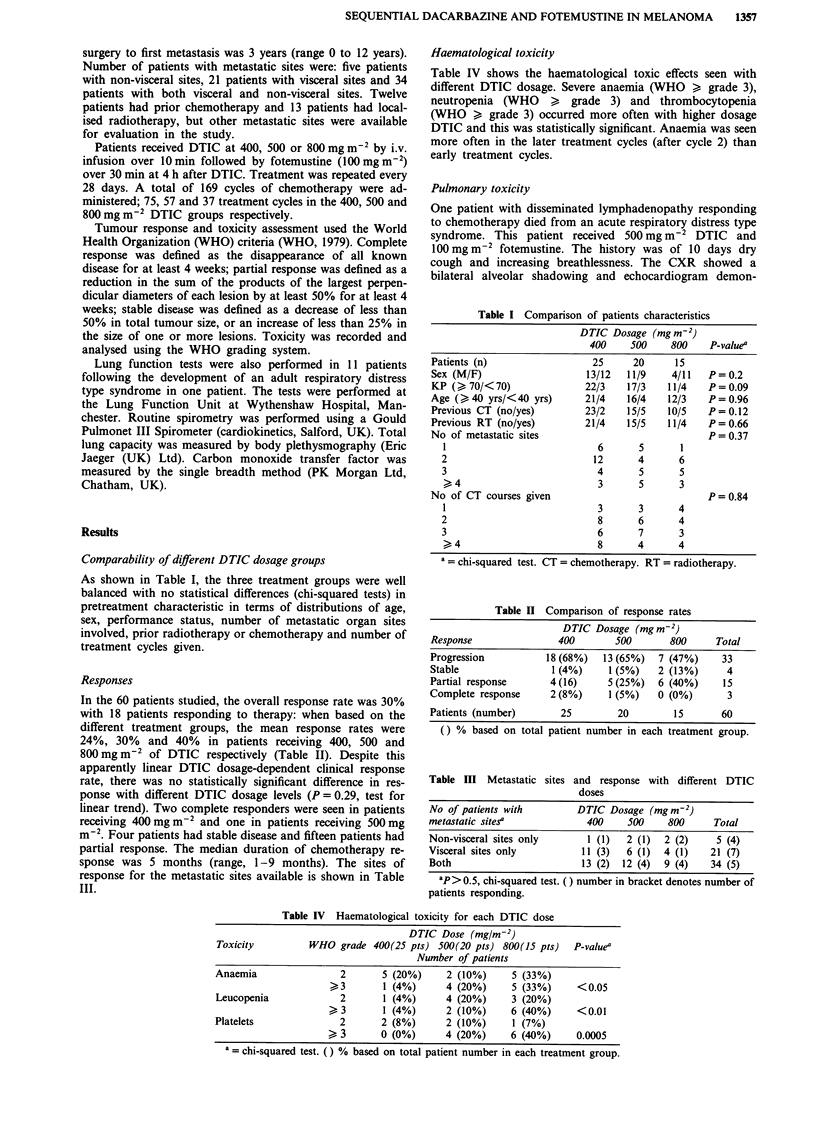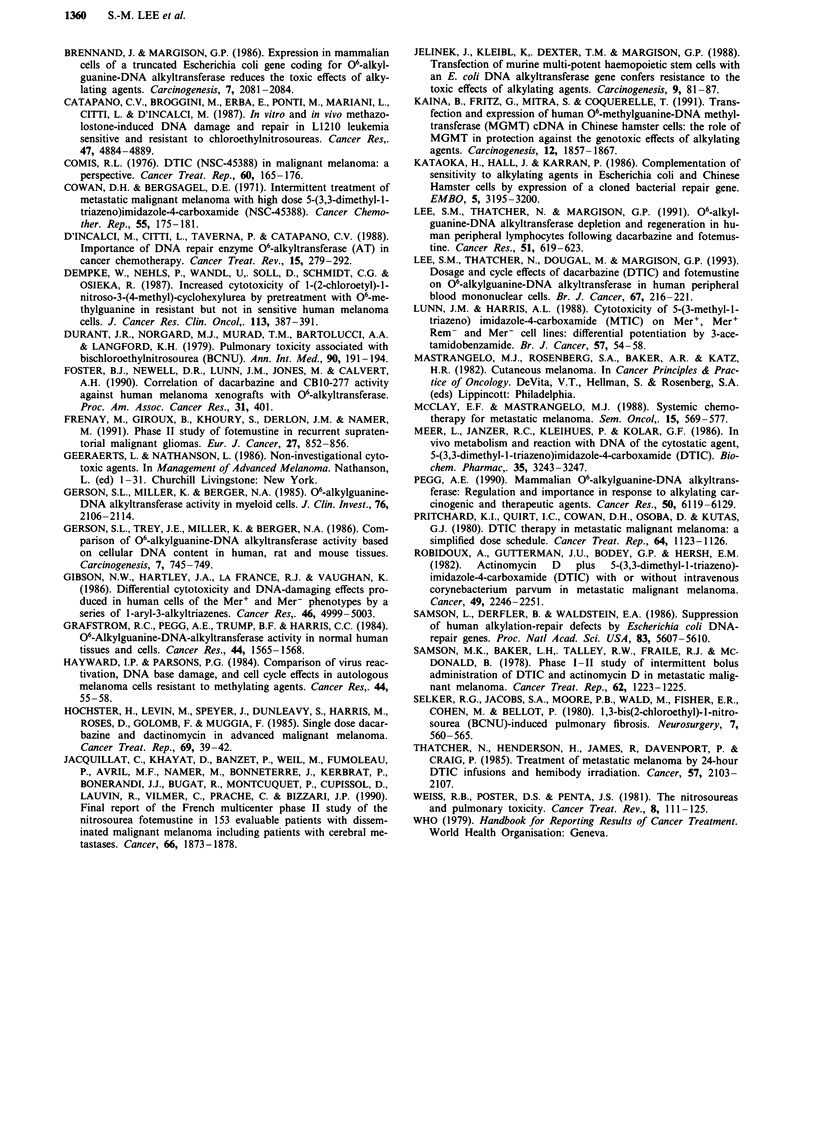Abstract
There is increasing experimental evidence to suggest that expression of O6-alkylguanine-DNA-alkyltransferase (ATase) is a major factor in resistance to dacarbazine (DTIC). We recently demonstrated a progressive ATase depletion in human peripheral lymphocytes with nadir levels occurring at 4-6 h after DTIC administration (Lee et al., 1991). Therefore in an attempt to improve the clinical response rate of DTIC, fotemustine was administered 4 h after DTIC administration; since in the case of fotemustine, ATase removes the chloroethyl lesions from the O6-position of guanine, thereby preventing the formation of the cytotoxic cross-links. Sixty patients with widely metastatic melanoma received DTIC at 400, 500 or 800 mg m-2 followed by fotemustine (100 mg m-1) at 4 h after DTIC administration. Treatment was repeated every 28 days with a total of 169 cycles of chemotherapy administered; 75, 57 and 37 treatment cycles with 400, 500 and 800 mg m-2 DTIC groups respectively. Eighteen of the 60 patients responded (with three complete response); response rates were linearly related to dose, being 24%, 30% and 40% in patients receiving 400, 500 and 800 mg m-2 of DTIC respectively and the overall response rate was 30%. Median survival was 3.6 months (range, 1-15 months) with no statistically significant difference between the different DTIC treatment groups (P = 0.67). Nine patients are alive at 5 to 26 months (median 10 months); three patients with no tumour and five patients with stable disease. A statistically significant relationship was seen between the development of severe haematological toxicity (WHO > or = 3) with increasing dosage of DTIC and significant subclinical pulmonary damage was seen in 11 patients where the lung function was monitored during the course of treatment. In conclusion, it appears that with this small group of patients, escalation of DTIC dosage might not significantly affect response rates but does increase haematological toxicity. The present study provides a framework for other studies in an attempt to modulate ATase-mediated drug resistance in tumour tissues but the associated toxicity will need careful monitoring.
Full text
PDF




Selected References
These references are in PubMed. This may not be the complete list of references from this article.
- Aronin P. A., Mahaley M. S., Jr, Rudnick S. A., Dudka L., Donohue J. F., Selker R. G., Moore P. Prediction of BCNU pulmonary toxicity in patients with malignant gliomas: an assessment of risk factors. N Engl J Med. 1980 Jul 24;303(4):183–188. doi: 10.1056/NEJM198007243030403. [DOI] [PubMed] [Google Scholar]
- Bailey C. C., Marsden H. B., Jones P. H. Fatal pulmonary fibrosis following 1,3-bis(2-chloroethyl)-1-nitrosourea (BCNU) therapy. Cancer. 1978 Jul;42(1):74–76. doi: 10.1002/1097-0142(197807)42:1<74::aid-cncr2820420111>3.0.co;2-i. [DOI] [PubMed] [Google Scholar]
- Brennand J., Margison G. P. Expression in mammalian cells of a truncated Escherichia coli gene coding for O6-alkylguanine alkyltransferase reduces the toxic effects of alkylating agents. Carcinogenesis. 1986 Dec;7(12):2081–2084. doi: 10.1093/carcin/7.12.2081. [DOI] [PubMed] [Google Scholar]
- Catapano C. V., Broggini M., Erba E., Ponti M., Mariani L., Citti L., D'Incalci M. In vitro and in vivo methazolastone-induced DNA damage and repair in L-1210 leukemia sensitive and resistant to chloroethylnitrosoureas. Cancer Res. 1987 Sep 15;47(18):4884–4889. [PubMed] [Google Scholar]
- Comis R. L. DTIC (NSC-45388) in malignant melanoma: a perspective. Cancer Treat Rep. 1976 Feb;60(2):165–176. [PubMed] [Google Scholar]
- Cowan D. H., Bergsagel D. E. Intermittent treatment of metastatic malignant melanoma with high-dose 5-(3,3-dimethyl-1-triazeno)imidazole-4-carboxamide (NSC-45388). Cancer Chemother Rep. 1971 Apr;55(2):175–181. [PubMed] [Google Scholar]
- D'Incalci M., Citti L., Taverna P., Catapano C. V. Importance of the DNA repair enzyme O6-alkyl guanine alkyltransferase (AT) in cancer chemotherapy. Cancer Treat Rev. 1988 Dec;15(4):279–292. doi: 10.1016/0305-7372(88)90026-6. [DOI] [PubMed] [Google Scholar]
- Dempke W., Nehls P., Wandl U., Soll D., Schmidt C. G., Osieka R. Increased cytotoxicity of 1-(2-chloroethyl)-1-nitroso-3(4-methyl)-cyclohexylurea by pretreatment with O6-methylguanine in resistant but not in sensitive human melanoma cells. J Cancer Res Clin Oncol. 1987;113(4):387–391. doi: 10.1007/BF00397725. [DOI] [PubMed] [Google Scholar]
- Durant J. R., Norgard M. J., Murad T. M., Bartolucci A. A., Langford K. H. Pulmonary toxicity associated with bischloroethylnitrosourea (BCNU). Ann Intern Med. 1979 Feb;90(2):191–194. doi: 10.7326/0003-4819-90-2-191. [DOI] [PubMed] [Google Scholar]
- Frenay M., Giroux B., Khoury S., Derlon J. M., Namer M. Phase II study of fotemustine in recurrent supratentorial malignant gliomas. Eur J Cancer. 1991;27(7):852–856. doi: 10.1016/0277-5379(91)90133-x. [DOI] [PubMed] [Google Scholar]
- Gerson S. L., Miller K., Berger N. A. O6 alkylguanine-DNA alkyltransferase activity in human myeloid cells. J Clin Invest. 1985 Dec;76(6):2106–2114. doi: 10.1172/JCI112215. [DOI] [PMC free article] [PubMed] [Google Scholar]
- Gerson S. L., Trey J. E., Miller K., Berger N. A. Comparison of O6-alkylguanine-DNA alkyltransferase activity based on cellular DNA content in human, rat and mouse tissues. Carcinogenesis. 1986 May;7(5):745–749. doi: 10.1093/carcin/7.5.745. [DOI] [PubMed] [Google Scholar]
- Gibson N. W., Hartley J. A., LaFrance R. J., Vaughan K. Differential cytotoxicity and DNA-damaging effects produced in human cells of the Mer+ and Mer- phenotypes by a series of 1-aryl-3-alkyltriazenes. Cancer Res. 1986 Oct;46(10):4999–5003. [PubMed] [Google Scholar]
- Hayward I. P., Parsons P. G. Comparison of virus reactivation, DNA base damage, and cell cycle effects in autologous human melanoma cells resistant to methylating agents. Cancer Res. 1984 Jan;44(1):55–58. [PubMed] [Google Scholar]
- Hochster H., Levin M., Speyer J., Dunleavy S., Harris M., Roses D., Golomb F., Muggia F. Single-dose dacarbazine and dactinomycin in advanced malignant melanoma. Cancer Treat Rep. 1985 Jan;69(1):39–42. [PubMed] [Google Scholar]
- Jacquillat C., Khayat D., Banzet P., Weil M., Fumoleau P., Avril M. F., Namer M., Bonneterre J., Kerbrat P., Bonerandi J. J. Final report of the French multicenter phase II study of the nitrosourea fotemustine in 153 evaluable patients with disseminated malignant melanoma including patients with cerebral metastases. Cancer. 1990 Nov 1;66(9):1873–1878. doi: 10.1002/1097-0142(19901101)66:9<1873::aid-cncr2820660904>3.0.co;2-5. [DOI] [PubMed] [Google Scholar]
- Jelinek J., Kleibl K., Dexter T. M., Margison G. P. Transfection of murine multi-potent haemopoietic stem cells with an E. coli DNA alkyltransferase gene confers resistance to the toxic effects of alkylating agents. Carcinogenesis. 1988 Jan;9(1):81–87. doi: 10.1093/carcin/9.1.81. [DOI] [PubMed] [Google Scholar]
- Kaina B., Fritz G., Mitra S., Coquerelle T. Transfection and expression of human O6-methylguanine-DNA methyltransferase (MGMT) cDNA in Chinese hamster cells: the role of MGMT in protection against the genotoxic effects of alkylating agents. Carcinogenesis. 1991 Oct;12(10):1857–1867. doi: 10.1093/carcin/12.10.1857. [DOI] [PubMed] [Google Scholar]
- Kataoka H., Hall J., Karran P. Complementation of sensitivity to alkylating agents in Escherichia coli and Chinese hamster ovary cells by expression of a cloned bacterial DNA repair gene. EMBO J. 1986 Dec 1;5(12):3195–3200. doi: 10.1002/j.1460-2075.1986.tb04629.x. [DOI] [PMC free article] [PubMed] [Google Scholar]
- Lee S. M., Thatcher N., Dougal M., Margison G. P. Dosage and cycle effects of dacarbazine (DTIC) and fotemustine on O6-alkylguanine-DNA alkyltransferase in human peripheral blood mononuclear cells. Br J Cancer. 1993 Feb;67(2):216–221. doi: 10.1038/bjc.1993.42. [DOI] [PMC free article] [PubMed] [Google Scholar]
- Lee S. M., Thatcher N., Margison G. P. O6-alkylguanine-DNA alkyltransferase depletion and regeneration in human peripheral lymphocytes following dacarbazine and fotemustine. Cancer Res. 1991 Jan 15;51(2):619–623. [PubMed] [Google Scholar]
- Lunn J. M., Harris A. L. Cytotoxicity of 5-(3-methyl-1-triazeno)imidazole-4-carboxamide (MTIC) on Mer+, Mer+Rem- and Mer- cell lines: differential potentiation by 3-acetamidobenzamide. Br J Cancer. 1988 Jan;57(1):54–58. doi: 10.1038/bjc.1988.8. [DOI] [PMC free article] [PubMed] [Google Scholar]
- Mc Clay E. F., Mastrangelo M. J. Systemic chemotherapy for metastatic melanoma. Semin Oncol. 1988 Dec;15(6):569–577. [PubMed] [Google Scholar]
- Meer L., Janzer R. C., Kleihues P., Kolar G. F. In vivo metabolism and reaction with DNA of the cytostatic agent, 5-(3,3-dimethyl-1-triazeno)imidazole-4-carboxamide (DTIC). Biochem Pharmacol. 1986 Oct 1;35(19):3243–3247. doi: 10.1016/0006-2952(86)90419-3. [DOI] [PubMed] [Google Scholar]
- Pegg A. E. Mammalian O6-alkylguanine-DNA alkyltransferase: regulation and importance in response to alkylating carcinogenic and therapeutic agents. Cancer Res. 1990 Oct 1;50(19):6119–6129. [PubMed] [Google Scholar]
- Pritchard K. I., Quirt I. C., Cowan D. H., Osoba D., Kutas G. J. DTIC therapy in metastatic malignant melanoma: a simplified dose schedule. Cancer Treat Rep. 1980 Oct-Nov;64(10-11):1123–1126. [PubMed] [Google Scholar]
- Robidoux A., Gutterman J. U., Bodey G. P., Sr, Hersh E. M. Actinomycin-D plus 5-(3,3-dimethyl-1-triazeno)-imidazole-4-carboxamine (DTIC) with or without intravenous Corynebacterium parvum in metastatic malignant melanoma. Cancer. 1982 Jun 1;49(11):2246–2251. doi: 10.1002/1097-0142(19820601)49:11<2246::aid-cncr2820491108>3.0.co;2-d. [DOI] [PubMed] [Google Scholar]
- Samson L., Derfler B., Waldstein E. A. Suppression of human DNA alkylation-repair defects by Escherichia coli DNA-repair genes. Proc Natl Acad Sci U S A. 1986 Aug;83(15):5607–5610. doi: 10.1073/pnas.83.15.5607. [DOI] [PMC free article] [PubMed] [Google Scholar]
- Samson M. K., Baker L. H., Talley R. W., Fraile R. J., McDonald B. Phase I--II study of intermittent bolus administration of DTIC and actinomycin D in metastatic malignant melanoma. Cancer Treat Rep. 1978 Aug;62(8):1223–1225. [PubMed] [Google Scholar]
- Selker R. G., Jacobs S. A., Moore P. B., Wald M., Fisher E. R., Cohen M., Bellot P. 1,3-Bis(2-chloroethyl)-1-nitrosourea (BCNU)-induced pulmonary fibrosis. Neurosurgery. 1980 Dec;7(6):560–565. doi: 10.1227/00006123-198012000-00003. [DOI] [PubMed] [Google Scholar]
- Thatcher N., Anderson H., James R., Davenport P., Craig P. Treatment of metastatic melanoma by 24-hour DTIC infusions and hemibody irradiation. Cancer. 1986 Jun 1;57(11):2103–2107. doi: 10.1002/1097-0142(19860601)57:11<2103::aid-cncr2820571102>3.0.co;2-g. [DOI] [PubMed] [Google Scholar]
- Weiss R. B., Poster D. S., Penta J. S. The nitrosoureas and pulmonary toxicity. Cancer Treat Rev. 1981 Jun;8(2):111–125. doi: 10.1016/s0305-7372(81)80031-x. [DOI] [PubMed] [Google Scholar]


